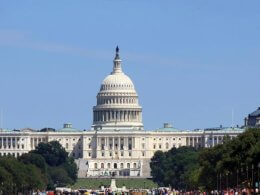On Tuesday, the Ronald Reagan Institute disclosed in its second annual National Security Innovation Base report card that the United States faced challenges in modernizing and innovating defense technologies to secure a competitive edge against China and other enemies.
The latest report highlighted the necessity for improved coordination among U.S. government, private sector, and military to avoid potential embarrassment on the global stage. The report was assembled by prominent defense specialists who assigned various grades, including Bs, Cs, Ds, and even one F-.
Rachel Hoff, policy director at the Reagan Institute and one of the authors of the report, informed journalists during a briefing before the launch of the scorecard that six out of the 10 areas evaluated in the Reagan scorecard showed either no improvement or a decline in performance compared to the previous year. According to Hoff, this suggests that while there have been some positive developments, known as "green shoots," there hasn't been substantial progress in translating these developments into significant momentum forward.
The report evaluates the performance of the U.S. government across ten critical areas to gauge the strength of the 'National Security Innovation Base' (NSIB), particularly as America's military, economic, and technological edge diminishes in comparison to China. According to the report card, the U.S. is a prominent global innovator with a thriving private sector. However, lingering weaknesses pose significant risks to America's competitiveness and could result in the U.S.'s military inferiority.
Roger Zakheim, director of the Reagan Institute, emphasized the importance of integrating new technologies into the national security framework to uphold America's superiority over its primary competitor, China. He stated that despite the private sector's global innovation leadership and some advancements by the U.S. government in the past year, there's a critical juncture where innovation priorities must effectively translate into tangible capabilities.
"We're still looking for the ability to translate and transition those innovation priorities into capabilities, into programs of record, into budget priorities," Hoff explained to reporters.
The report highlights that government initiatives face a challenge in securing adequate funding and establishing programs to support them. This issue stems from budget constraints and dysfunction in congressional appropriations, hindering the transformation of innovation into actionable capabilities. The government received a low F score due to its failure to adequately and consistently fund new technologies. The report highlights that Congress's lack of action hinders progress on essential projects, and the absence of a budget for the fiscal year 2024 is causing significant delays in critical programs.
"Since the U.S. comprises more than 40 percent of world military spending, the idea that a lack of funding is what's preventing defense innovation is preposterous," said Justin Logan, director of defense and foreign policy studies at the Cato Institute. The national security establishment is stuck in the 1990s," Logan told The Foreign Desk.
The report emphasizes inadequate funding for the advancement of new 'collaborative combat aircraft.' It expresses worries about Congress' commitment to enhancing vital technology, pointing out the unchanged budget allocations for innovation in the FY2024 National Defense Authorization Act (NDAA).
Additional sectors within the defense industry also received less favorable grades. The concept of defense modernization, which encompasses upgrading U.S. armed forces and national security capabilities to meet 21st-century standards, received a grade of D.
The report card graded "customer clarity" with a D. It cautioned that advancements within the Pentagon, CIA, and other vital components of the national security framework have been significantly undermined due to the congressional inability to pass a budget. This failure is constraining progress and weakening the incentive for industry and investors to engage.
"Many of the problems are more structural than related to funding," said Wilson Beaver, senior policy analyst for defense budgeting at The Heritage Foundation's Allison Center for National Security.
"For example, a small number of companies are taking up too large a percentage of SBIR awards and then failing to transition. This is stifling innovation in a program that is designed to help small businesses and startups bring new ideas into the defense marketplace. Even worse, SBIR and other defense grant programs lack the necessary research security protections to ensure the Chinese aren't stealing tech funded by the American government," Beaver told The Foreign Desk.
The national security workforce was also graded as a D. According to the report, concerns about an aging workforce and demographic shifts suggest ongoing challenges in matching skills efficiently and manually handling burdensome vetting procedures.
Dale Swartz, a partner at McKinsey and Company, a consulting firm specializing in business management based in Washington, D.C., collaborated with Reagan on the report. He highlighted that startups and nontraditional defense firms pointed out various non-financial barriers during multiple interviews conducted by the authors. These obstacles included limited access to classified areas and essential testing facilities like wind tunnels. Additionally, they emphasized the extended process for employees to acquire security clearances as another significant challenge.
The report card was published after the Biden administration proposed an $850 billion budget for the Pentagon for the upcoming fiscal year, starting in October. This represents a 4.2% rise from the $815.9 billion requested in the 2023 fiscal year and a similar increase from the $817.3 billion provided in the continuing resolution for fiscal year 2024. The continuing resolution maintains spending at the previous year's level and restricts Pentagon officials from starting new programs.
In Washington, national security experts increasingly worry about insufficient funding to maintain a competitive edge against U.S. adversaries, particularly communist China. The depletion of stockpiles seems to be on the rise as weapons are sent to allies like Ukraine.
"The US cannot pursue a 'more of everything' strategy. Strategy is about choice, and the central defense challenge is China. If the U.S. would adopt a more prudent strategy, it could cut defense spending dramatically and still stay well ahead of China," Logan said.
Related Story: Report: U.S. Air Force Too Weak to Confront China










